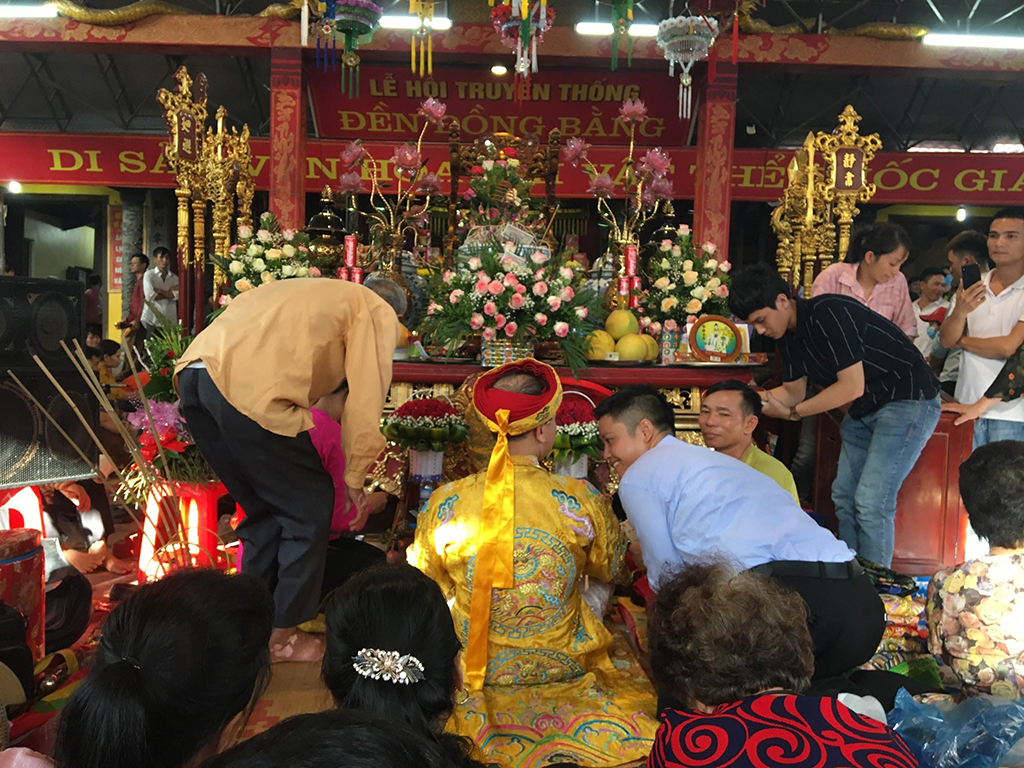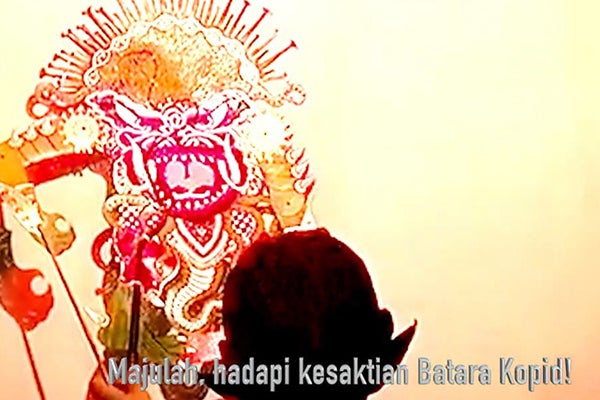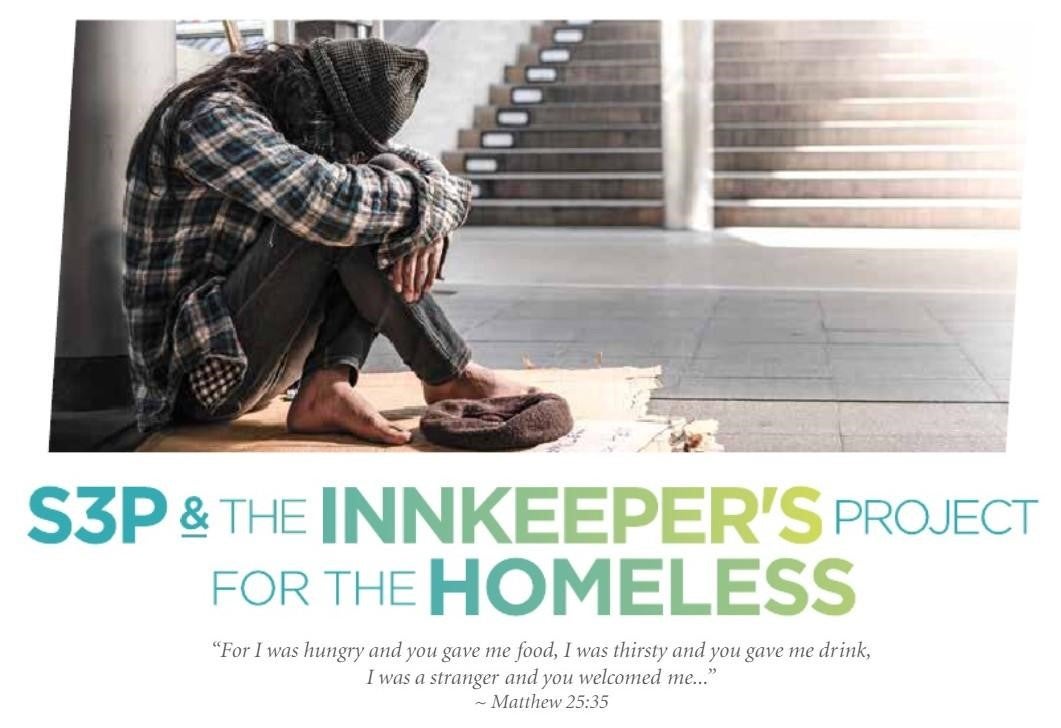Jewish Prayer Quorums in the Shadow of Corona: Congregating for Prayer when Congregating is Prohibited
contributed by Levi Cooper, 17 August 2021
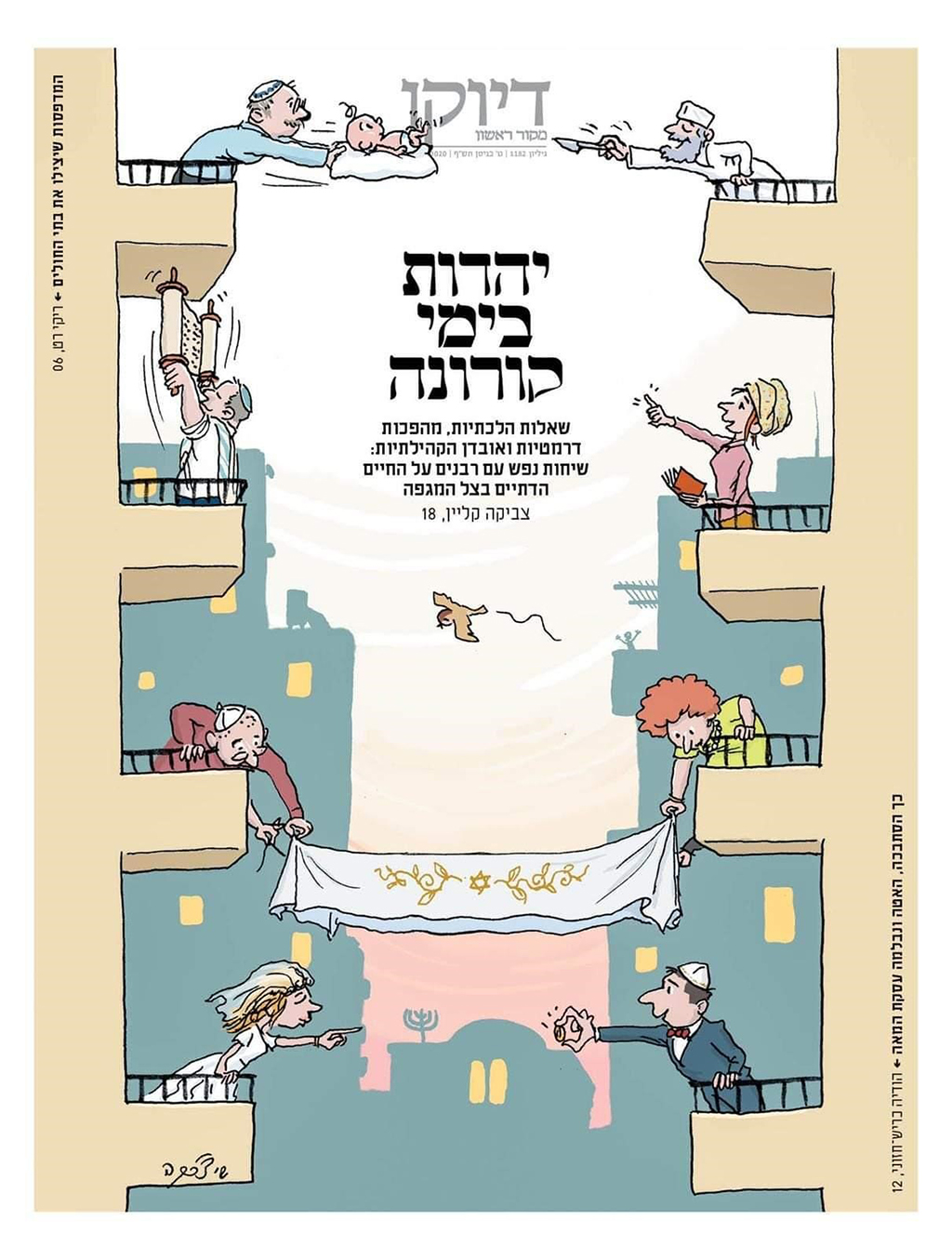
Figure 1.This illustration, by Shay Charka, playfully depicts three Jewish rituals during stay-at-home orders: circumcision, prayer, and marriage. A participant cheers from a distant building; the silhouette of a synagogue is visible in the centre background. Published as the front cover of the weekend magazine of the Makor Rishon newspaper, 3 April 2020. The Hebrew title reads “Yahadut bimei korona” [Judaism in the Days of Corona].
Praying with a Minyan
The rhythm of Jewish religious life involves three daily prayer services – one in the morning, one in the afternoon, and one in the evening. These services are conducted with the participation of a quorum of ten or more, known in Hebrew as a minyan (literally: number). Traditionally such a quorum is comprised of at least ten Jewish males over the age of thirteen. Liberal streams of Judaism have chosen to include all genders, redefining a quorum as minimum ten Jewish adults.
Praying together as a quorum is not just a religious obligation, it is also central to personal identity, spiritual experience, communal affiliation, and social networks.
Many Jews do not attend services at a synagogue for the three daily prayers. It is, however, common for affiliated Jews to go to the synagogue on Shabbat – the Jewish day of rest – even if they do not participate in daily services. Indeed, the weekly Shabbat service is the zenith of the Jewish communal experience.
The Quest for a Quorum
Government ordered lockdowns impeded the possibility of gathering for prayer. Early on in the pandemic there was a range of rabbinic responses as to how to navigate stay-at-home orders that brought much of religious communal life to a standstill. As understandings of the dangers of the contagion evolved, rabbinic leaders encouraged the closure of synagogues. Notwithstanding the regulations and advice, many Jews sought alternative techniques to continue praying in a quorum.
In this post, I outline the makeshift prayer quorums that existed despite shuttered synagogues, severe crowd-limiting measures, social-distancing requirements, and general advice against gathering. To create this categorisation, I have tracked solutions in a range of locations, including Australia, Canada, England, Israel, South Africa, and the United States of America.
Improvised prayer gatherings during COVID-19 have taken different forms that can be divided into five categories:
- Pirate quorums
- Balcony quorums (Hebrew: minyan mirpasot)
- Outdoor, including courtyard and backyard, street and sidewalk
- Mobile, including drive-in, drive-thru, and drive-by
- Virtual
These ad hoc gatherings also produced hybrid forms, such as joining a street quorum from a balcony. Previously I have documented virtual prayer gatherings. In this essay I focus on embodied quorums during the Coronavirus pandemic.
Pirate Quorums
quorums gathered for prayer in a manner that was prohibited by government-imposed Pirate COVID restrictions. In order to avoid detection these illegal gatherings have generally assembled away from the public eye, often inside buildings, thereby increasing the danger of spreading the virus.
At the very minimum, such “pirate” gatherings required ten people to collude in the illicit venture. Presumably, information about these gatherings was spread by word of mouth or via internal communication channels. In addition, reports emerged of signs posted outside synagogues announcing the closure of the premises, together with directions in Yiddish or in Aramaic instructing people how to enter surreptitiously.
In some instances, Jewish organisations petitioned governments to obtain official permission to hold services. Alternatively, they turned to the courts to contest the authority of the laws limiting prayer gatherings on the grounds that such laws were discriminatory, or that prayer gatherings were a necessary service, or that congregating did not pose a danger to public health. Political and judicial attempts to legalise pirate quorums were unsuccessful. In Israel, religious parties were members of the government, and as such they were active in setting the restrictive guidelines and determining which prayer gatherings were outlawed. Notwithstanding the legislative involvement of political representatives of religious groups of Israeli society, pirate quorums still existed.
By their nature, pirate gatherings were secretive and only drew attention when they were discovered by the police and critiqued in the press. It is difficult to quantify how many people participated in unlawful quorums, however the phenomenon existed in many locations around the world.
While providing a solution for those who felt the ritual obligation to pray in a quorum, these gatherings resulted in tension within the Jewish community. Tensions were rooted in two concerns:
- Illegal gatherings clashed with state law and were therefore a blight on all Jews in the eyes of law-abiding sectors of the community. This was particularly apparent when such gatherings were raided by the police and reported by journalists.
- Attendees at pirate quorums were accused of further spreading the virus, or at least not sharing the burden of curbing the outbreak and ‘flattening the curve’.
Given the illegal nature of pirate quorums, as soon as assembling was permitted or synagogues were reopened, such gatherings ceased to exist or at least ceased to be proscribed. Pirate gatherings provided a truly ad hoc solution for those who were determined to pray in a quorum, and therefore, cannot be expected to have a long-term impact on Jewish religious practice.
It remains to be seen whether the tensions surrounding these criminal prayer groups will leave lasting scars. These tensions often tapped into existing fissures between different sectors of the Jewish community regarding compliance with secular state laws and regarding notions of shared burdens of responsibility. Seen in this light, pirate quorums reflect spot fires that were by-products of a larger conflagration.
Balcony Quorums
A second form of makeshift prayer gathering was the balcony quorum: participants remained at home but formed prayer quorums when standing on their balconies (Figure 1, Figure 2). These gatherings offered participants the possibility of joining a prayer service, while adhering to government guidelines. Like virtual prayer participation (Figure 3), balcony quorums offered the benefits of praying from the comfort of home.

Figure 2. Photo credit: Shuki Lehrer. Bnei Brak, Israel, 16 April 2020. Source: JDN photo gallery.

Figure 3. Jon Clark, “Pro and cons of zoom church,” Honest Jon, 19 May 2020. Source: https://www.facebook.com/honestjoncomicsLDS/photos/todays-honest-jon-more-reasons-to-zoom-or-not-to-zoom-churchhonestjoncomicszoomc/1702878829877911/
Balcony quorums raised issues regarding Jewish law and ritual. For example: What physical conditions tie a group of people together for the sake of creating a prayer quorum?Should the boundary be determined by line of sight, by the ability to hear the prayer leader, or perhaps by a measure of actual physical distance? Could people in entirely different settings or locations be conjoined for the purposes of a prayer quorum? Such issues enjoyed real-time animated discussion by rabbinic authorities. Responses or summaries of relevant sources were published online as the issues were unfolding.
Balcony quorums provided a good temporary solution for those determined to pray in a quorum during lockdown. Naturally, the formation of such quorums was limited to an urban landscape that included high-rise buildings constructed in close proximity to each other. Balcony quorums also formed where multi-story dwellings opened up onto a shared space, with the commons serving as the service’s focal point.
The separation and physical distance between the participants meant that balcony quorums did not form new communities. Thus, they too disbanded when it became possible to gather at the synagogue, or we can expect they will discontinue in the future.
Outdoor quorums
While the balcony quorum was an appropriate response for dense, multi-story structures, other urban landscapes provided room for different types of gatherings, which I call outdoor quorums. These prayer gatherings formed in various locations, including in the backyard of homes or in the courtyard of residential buildings, in the streets or on the sidewalks.
Outdoor prayer gatherings were conducted in private gardens, shared spaces, or public areas, and they all shared two salient features. Firstly, they did not contravene government restrictions in the way pirate quorums did. Secondly, They did not raise the same questions of Jewish ritual law as balcony quorums did.
Outdoor quorums described themselves as temporary solutions, whose participants were yearning to return to communal institutions for in-person gathering.
As COVID restrictions were lifted, synagogues reopened and began to resume communal gathering. Despite the possibility of returning to pre-pandemic prayer arrangements, there have been cases of outdoor quorums continuing to operate. Participants in these gatherings have not necessarily rushed to re-join their former synagogues.
Regular participants in outdoor quorums often coalesced into new communities. The shared experience of grappling with adversity created a bond between attendees. In addition, these new communities were intimate, close to home, less formal, open to experiment, and lacking rabbinic oversight and control.
Outdoor quorums were reminiscent of the shtibl (Yiddish: small room) model of prayer communities once so prevalent in cities; albeit without the actual shtibl. Might this be indicative of a move away from large synagogues and a return to the shtibl? Or is this a specific pandemic-related development?
It remains to be seen whether participants in outdoor quorums will return to their former synagogue communities as the pandemic recedes. Much will depend on whether these nascent communities are able to find weather-appropriate spaces for gathering. Moreover, competition over the use of public spaces will also likely be a decisive factor.
Mobile prayer services
There was a makeshift prayer route that bears mentioning for its comparative value: mobile prayer services. Christian communities conducted drive-in, drive-thru, and drive-by services. To clarify the terms:
- Drive-in: congregants drove to a parking lot and participated in the service from within their vehicles.
- Drive-thru: congregants drove past stationary clergy.
- Drive-by: clergy drove past home-bound congregants.
Some communities had employed these modes prior to COVID-19, but they received greater prominence during the pandemic. Were there parallel mobile Jewish quorums?
Traditional Jewish law does not permit driving a car on Shabbat – the keystone of the communal prayer experience. Thus Shabbat services that involved driving a car could only be considered by denominations that permitted driving on the Jewish day of rest (Figure 4).

Figure 4. Advertisement for drive-in Shabbat services in Bet Shira congregation, Pinecrest, Florida, https://www.betshira.org
Drive-thru and drive-by mechanisms could not be construed as a quorum, because they did not have the presence of the requisite ten. Yet the drive-by solution was used for another Jewish ritual. In April 2020, the city council of Beitar Illit paraded trees through the streets so that people could recite the annual Spring blessing over the blossoming of fruit trees (Figure 5).
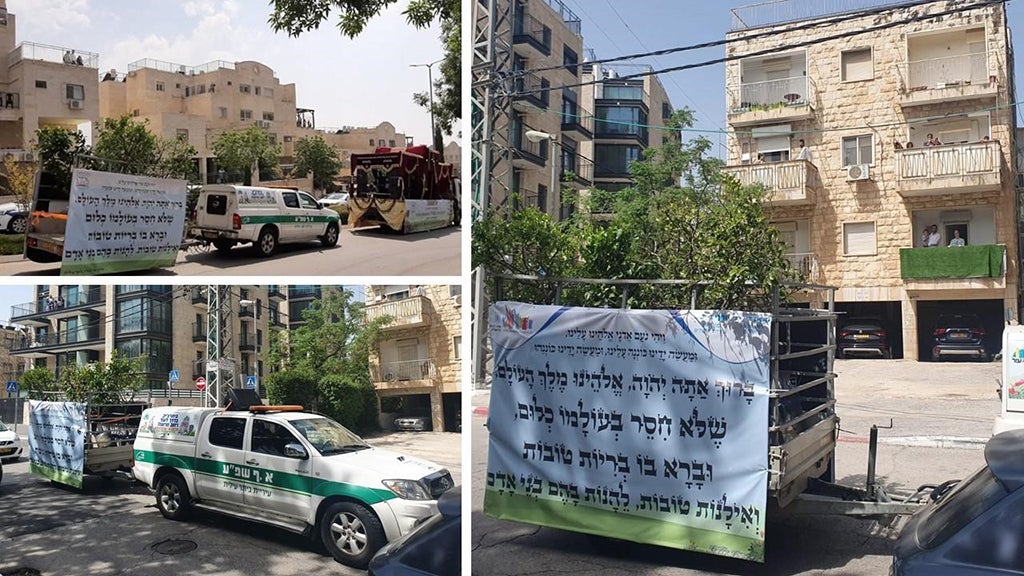
Figure 5. Blossoming fruit trees driven through the city of Beitar Illit in April 2020. The sign on the side of the trailer has the text of the blessing that is traditionally recited in spring. In the background families look on from the balconies of their apartments. Source: Michal Levi, “Masait ha-ilanot shel Beitar Illit” [the tree truck of Beitar Illit]. Arutz sheva, 20 April 2020, https://www.inn.co.il/news/434417 and Yehonatan Hayim, “Le-hanot bahem benei adam” [to give pleasure through them to humans], Merkaz ha-‘inyanim, 22 April 2020, https://tinyurl.com/h5uzx7na
Reflections
Surveying the various embodied forms of provisional prayer gatherings during COVID lockdowns – and adding virtual prayer meetings to the mix – allows for reflection on the role and significance of the prayer quorum in Jewish communal and religious life:
- Even during periods when gathering to form a prayer quorum was prohibited or strongly discouraged, individuals and communities were determined to retain this ritual element.
- Some ad hoc solutions were instituted and coordinated by existing community leadership structures, while other ventures were grassroots initiatives.
- Some of the initiatives proceeded with rabbinic approval, others purposefully operated without rabbinic oversight or involvement.
- It is possible that improvised quorums that sprung up during the pandemic may survive beyond the timeline of the Covid crisis.
- Makeshift prayer quorums were a valiant – though in some cases illegal – attempt to preserve the rhythm of Jewish religious and communal life, even as the pandemic raged.
Disclaimer: The views and opinions expressed in this article are those of the authors and do not necessarily reflect the position of the blog editorial team or the Asia Research Institute.
South Asia | Southeast Asia | East Asia | Other Places | Hinduism | Buddhism | Islam | Christianity | Other Religions
Levi Cooper, originally from Melbourne, teaches at the Pardes Institute of Jewish Studies and in Tel Aviv University’s Law Faculty. His research focuses on interplays between Jewish legal writing and broader legal, historical, intellectual, and cultural contexts. Levi’s book, Relics for the Present, offers a contemporary commentary on the Talmud.
Other Interesting Topics
COVID-19 and Social Responsibility of Dao Mau’s Ritual Practitioners
A 26 year old spirit medium donning a pair of glasses and a disposable mask knocked on the main gate of an ancient temple in a suburb of Hanoi. The temple is dedicated to deities of Dao Mau - the Vietnamese beliefs in the Mother Goddesses of Three Realms. A few minutes later, the large, thick wooden gate still remained closed...
Javanese Wayang Kulit Responses to the COVID-19 Pandemic
Performances of the Javanese shadow theatre Wayang Kulit have traditionally been imbued with ritual character. Performances have been shown, for example, at important family or local celebrations, or during purification rituals for individuals or entire communities...
A Christian Response to the COVID-19 Pandemic
I am writing in a personal capacity about the response of a local Christian congregation and an inter-denominational Christian organization called the Bible Society of Singapore (新加坡圣经公会). To many Christians, their response was to meet new needs of the community generated by the pandemic...


